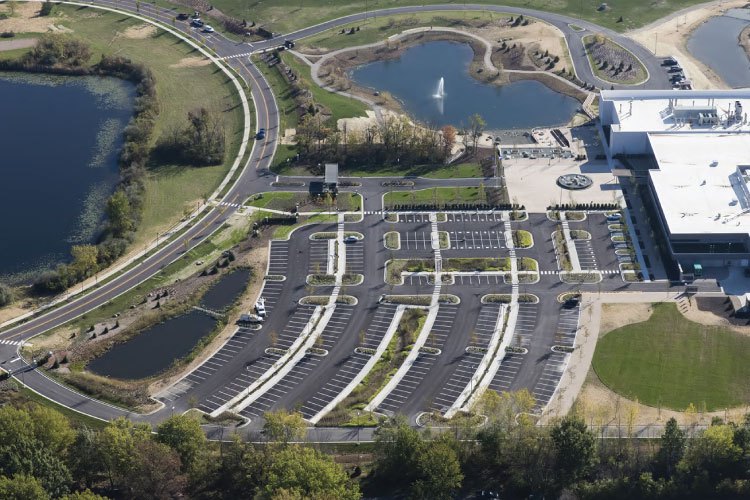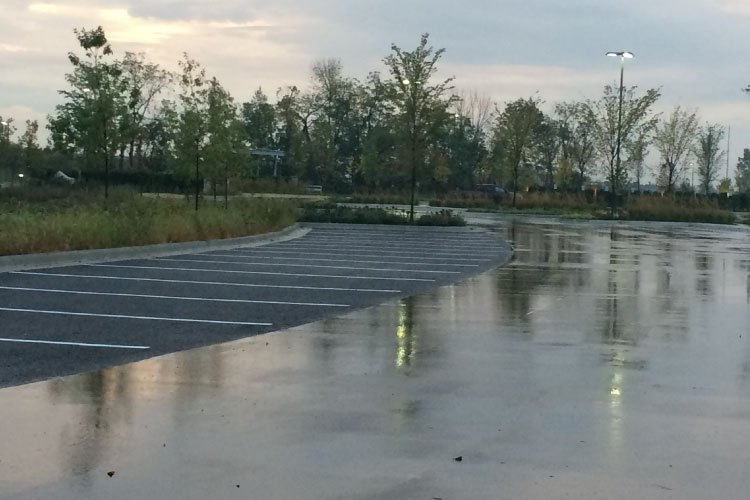 The Heritage Group opened its new Innovation Center and Research Laboratory in Indianapolis in August 2017. While the building and lab is a state-of-the-art facility, the associated roads and parking lots were also designed and built with state-of-the-practice innovation, features, and engineering prowess to ensure optimal performance.
The Heritage Group opened its new Innovation Center and Research Laboratory in Indianapolis in August 2017. While the building and lab is a state-of-the-art facility, the associated roads and parking lots were also designed and built with state-of-the-practice innovation, features, and engineering prowess to ensure optimal performance.
Too often, commercial development focuses on the facility itself with less emphasis on the pavement infrastructure. Pavement designs are often based on being the least initial cost with little concern for long-term performance. Construction can be rushed, with little oversight and inspection. Too often, the rush to get the facility open for business leads to the asphalt being placed in adverse weather conditions that should be avoided.
 The Heritage Group has extensive experience designing and building pavement systems all over the world for a wide range of applications. They applied this experience in the design, material selection, testing, and construction of the pavements around their new center and lab.
The Heritage Group has extensive experience designing and building pavement systems all over the world for a wide range of applications. They applied this experience in the design, material selection, testing, and construction of the pavements around their new center and lab.
Typical parking lot distresses
The team’s first task was to identify the failure mechanisms most often occurring on commercial asphalt parking pavements. They came up with the following:
Improper drainage — Parking lots have significant surface area and can collect water quickly. Proper drainage is critical to the long-term performance of the parking areas.
Cracking — Parking areas can show premature cracking, often at longitudinal joints or between concrete curbs at the interface with the asphalt. Cracks can also be caused by thermal expansion and contraction. Once water enters the pavement, expedited damage can occur from weakened subgrade, which then leads to fatigue cracking — sometimes described as alligator cracking.
Premature aging — Asphalt placement in parking lots typically requires significant hand work around structures. Besides the asphalt mix being more prone to segregation in these hand-placed areas, the compaction effort is often done with smaller rollers and is inconsistent. This results in pavements having high localized air voids, leading to high permeability of air and water due to interconnected voids.
Structural design — Commercial parking facilities tend to be structurally under-designed because of costs and underestimation of truck traffic. Local standards for thickness designs of parking areas typically vary based on subgrade strength and assumed truck traffic. It’s often assumed these parking lots will see no truck traffic, yet certain areas of the pavement such as delivery lanes see regular truck traffic and thus are under-designed.
Lack of fatigue resistance — Most parking lots never utilize premium materials such as modified asphalt binders that have polymers that can add flexibility and strength to the pavement. Modified asphalt binders can enhance performance, especially in high strain conditions, which are often the case in thinner pavement systems.
Unique features
The center’s final pavement designs utilized materials and features not typical of commercial parking lots or even roads.
Structural design — The roads were designed at 8 inches of compacted 36-mm top size aggregate base, with 4 inches of 19.0-mm Superpave hotmix asphalt (HMA), and two, 1-inch lifts of steel slag SMA 4.75 mm. The steel slag SMA 4.75 mm mix is identical to the current racing surface placed on the main oval of the Indianapolis Motor Speedway, but with improved binder properties. The parking areas were constructed using 6 inches of compacted #53 aggregate base, 3 inches of 19.0-mm Superpave HMA, and a 1-1/2-inch lift of 9.5 mm with dolomite.
Polymer Modified Asphalt (PMA) — Two polymer asphalt systems were selected. The roads used a PMA with a unique polymer combination that graded as a PG 82-22 (true grade 82-26) in the top two 1-inch steel slag SMA lifts. The parking areas used a PMA that graded as a PG 70-22 (true grade 74-24) in the 1.5-inch surface lift of 9.5 mm.
Mix performance testing — Performance testing was conducted on the surface mixtures, including IFIT (low-temperature cracking) and Hamburg (high-temperature rutting). Results were favorable.
Longitudinal joint sealant — Parking lots contain many longitudinal and transverse joints. The area around these joints tends to have higher air void levels, making them more prone to permeability, cracking, and raveling. An innovative technique to seal these joints from the bottom-up is called Longitudinal Joint Sealant (LJS) — named by the Illinois DOT.
The Heritage Group’s VRAM product is placed typically at a width of 12 or 18 inches on the underlying pavement by either a handheld drag box, push cart, or in-line spray bar, prior to the surface lift being placed. The heavily modified sealant is designed to wick up into the surface mix, thereby filling the voids around the joint, reducing permeability, increasing durability, and keeping the joint from opening up over time. Sealant was also applied along the concrete curb to create a flexible inner layer to keep the joint between the asphalt and concrete impermeable.
Low permeability — A void-filling emulsion was applied to all pavement surfaces. The emulsion (RPE) is designed to permeate into any interconnected voids of the surface mix, thereby making it impermeable. The unique penetrating qualities of this emulsion, along with careful application, is intended to leave little product on the surface and not adversely affect pavement friction.
Porous pavement design — In specific parking areas, a specialized porous pavement mix was placed with roughly 20 percent air voids to quickly drain the water. These porous layers have a subsurface collection basin that slowly releases to retention ponds. This eliminates flooding from stormwater runoff.
No bird baths — Before the surface lift was paved to all roads and parking areas, a survey was conducted to assess the ability to drain without ponding. A small milling machine was used to correct slope where needed to enable water to drain. Only a few small areas needed to be milled before the final surface lift was placed.
Conclusion
Too often, little attention is given to designing and constructing pavements for commercial properties. This can lead to early distresses, requiring crack filling and other repairs that are a poor reflection on the business. Innovative engineering and the use of premium materials should not just be reserved for highways. The design and construction of the pavements at Heritage Group’s new Innovation Center and Research Laboratory is an example of how long-term performance can be achieved, resulting in low maintenance and outstanding life-cycle costs long term.
Mark Buncher, Ph.D., P.E., is director of engineering at the Asphalt Institute (www.asphaltinstitute.org). Tony Kriech is vice president of Research and Development at the Heritage Research Group (http://hrglab.com/rd.html). This article is reprinted with permission from the spring 2018 issue of Asphalt magazine, published by the Asphalt Institute.
###




